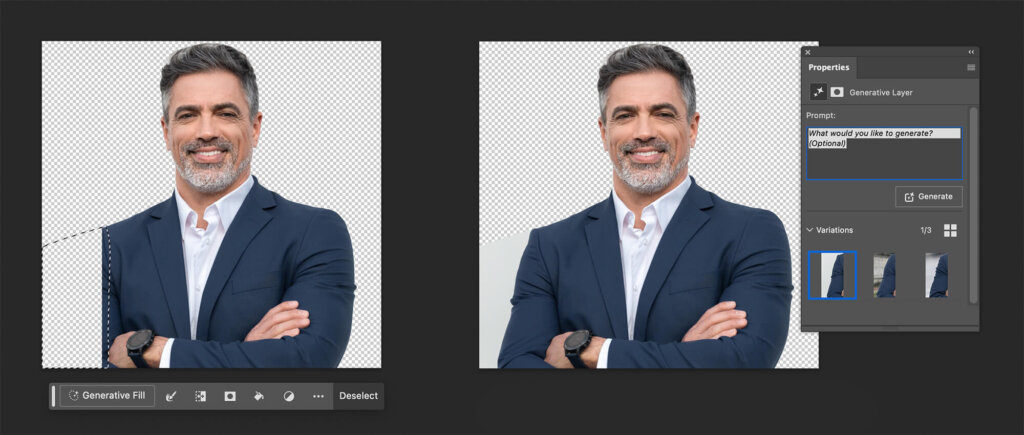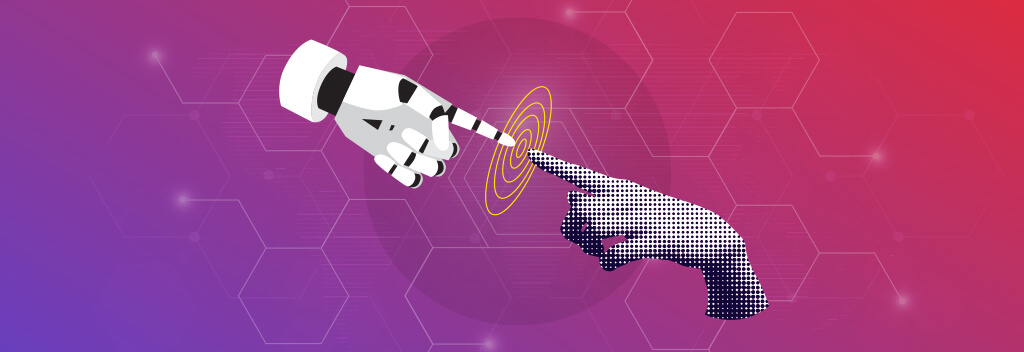Key points*
- AI boosts efficiency but requires human oversight to ensure it’s correct.
- AI is helpful for design edits, but not yet capable of correctly generating full images.
- Tools powered by AI can support content creation but don’t replace writers.
- We recommend using AI to help analyze data but it doesn’t drive strategy.
*This is an AI-assisted summary but was reviewed and edited by a writer for accuracy and clarity. No other sections of this article were generated using AI.
Artificial Intelligence has started infiltrating almost every aspect of our life – including the tools we use professionally and personally. While AI can do a variety of interesting things for us – from planning vacations and doing research – what we are most interested in is how we can leverage AI to streamline B2B marketing and design.
In this article, we’ll share a few ways we have started to incorporate AI into our daily work to better support the success of our B2B website and marketing partners. We also specifically discuss where we are cautious to incorporate AI and why.
AI in B2B Website Design
AI Image generators
While there are a great number of open-source and paid image generators out there, we don’t use them for our client work. We’ve found that where AI generators shine is in creating heavily stylized or fantasy imagery where rounds of specific edits or customizations aren’t needed.
Although AI photorealism is getting better, it’s not a great fit for our clients and stock photography fulfills our clients’ needs much better. Where a specific industry is concerned, the generators, like human artists, need accurate reference materials and may not properly understand industry terms leading to useless outputs. Even with more common terms and prompts, AI is still prone to major or minor visual hallucinations. Image issues typically appear in human anatomy, proportions, or composition which would be embarrassing to use and time-intensive to fix.
Embedded AI features in design tools
We do use embedded tools currently available as part of our paid design subscriptions – specifically those in Adobe Photoshop and to a lesser extent in Canva. Instead of full image generation, our goal has been to save time on minor tasks that are otherwise time-consuming.
Examples of the features we are leveraging include:
Canva
- The “background remover” function to remove logo backgrounds.
- The “magic expand” function to adjust photography backgrounds when adapting a design for different proportion variations.
Photoshop
- The “generative fill” feature to edit specific selection of existing photography. See the visual below for an example of the “generative fill” capability.
- The “neural filter” workspace features including “skin smoothing”, “jpeg artifact removal” and “photo restoration.”

Adobe Express
- We use Adobe Express for things like cropping out elements of a photo or quickly changing the color of an object. Adobe has great ethical standards, evidenced by the fact that its AI is trained through Adobe proprietary information and not the World Wide Web. Anything it creates and edits has high ethical standards and does not create copyright issues. AI is still in the early stages, so often Adobe Express is not able to create the desired results, and our designers need to continue editing the image or visual.
ChatGPT
When we are feeling uninspired or stuck on a problem, starting a conversation with ChatGPT is a great avenue to get out of a rut. It’s a great springboard for ideas and it is almost like another creative is in the room to talk through your creative ideas to see what is worth pursuing. Since ChatGPT uses the World Wide Web to get answers, it is a great barometer for popular culture and consensus.
For example, if we need to design a logo for a company that specializes in educational software for autistic children, we may ask ChatGPT questions like, “what are some popular symbols that represent primary education?” or “What are the symbols that the autistic community uses/recognizes?”
This question-and-answer process helps get ideas flowing, but we are always the ones executing the design and verifying if the questions and answers are correct by checking the sources used by ChatGPT.
Why we are cautious about using AI in our design work
- We want to minimize any ethical and legal issues for our web design agency, especially as AI expands. For example, we do not want to utilize AI generated images as we do not know what potentially proprietary human works they were trained on. Using these types of images can unknowingly open Bop Design or our clients up to copyright infringement of intellectual property.
- The industry-specific nature of our client needs is often better served by stock or custom imagery.
- The sheer number of options for both open-source and paid image generators requires more research and testing as each tends to have unique capabilities.
- For legal protection we would likely want to go with a paid model or one where we control the inputs the model is trained on – again a research and time investment.
- As AI tools, like ChatGPT, use the World Wide Web to generate responses, it’s important to use caution and check its answers to any prompts. Since it pulls from all over, this is a must for staying compliant and ethical. You don’t want to erroneously include inaccurate information or visually wrong imagery in any work you produce.
- In general, AI can help designers with time management and creative flow. However, even though AI has made great strides, human creativity and execution are still superior in the creative realm/fields.
AI in copywriting and content creation
Outlines and structure
While we do not use AI in the actual copywriting, we think it has value in helping to create outlines or suggest how to structure an article or content piece. Tools like ChatGPT, Gemini, and Perplexity are excellent resources for inputting a prompt about a specific topic and/or a tentative outline of a topic and asking for suggestions on organizing it.
Idea generation or keyword research
Similar to how we bounce ideas off of AI tools for design inspiration, it can be a great way to come up with ideas on certain topics. For our content marketing clients, we create editorial calendars based on competitive and industry research, along with SEO. Asking AI for blog topics on a particular keyword phrase is a helpful way to brainstorm new content ideas. While the topics that AI suggests often need work, they can be a great starting point or springboard for better ideas that are more specific to our client’s expertise.
Fine-tuning copy
Any copywriter knows the struggle of sitting and staring at a sentence or phrase and trying desperately to reword it in a small or more interesting way. Grammarly is a great tool for not only checking grammar on a particular piece of content, but its AI feature is immensely helpful in rewording small sections or sentences in a piece of text. It can also help suggest alternate tones for copy. An example is asking AI to reword a sentence, so it sounds more authoritative, friendly, or casual – depending on the client’s brand.
Creating variations of social posts or ads
We haven’t been impressed with what AI suggests for creative copy or social posts (we keep testing it to see if it improves), but it’s a great resource for creating several variations on copy we provide. Once we have drafted ad copy or a social post, we can use AI to create multiple versions of that copy. Putting in the original copy and asking for variations often provides a good amount of variety for the copy – however, much of it still needs to be tweaked so it doesn’t sound too casual or odd.
Our concerns about AI in content creation
- Copyright infringement and IP issues, particularly for tools that are using the internet to provide content based on prompts. As a safeguard for our agency and our clients, we do not allow any of our copywriters to use AI in content generation – unless in the ways mentioned above. If we say we are creating original content, it must be original and based on a specific client’s needs and offerings.
- We do use AI checkers on all content that we create to ensure it is unique and original. AI checkers aren’t 100% accurate, but they can give us a good overview on the likelihood the piece was human-written. We have a well-vetted team of writers who we trust, so the AI checkers are as much for their benefit as for ours. It’s also good job security for them!
- Thought leadership can’t be beat for experience and trustworthiness, so we limit how we use AI for our content creation. We have the privilege of partnering with many different industry innovators and it is counter-productive to rely on AI when we have ground-breaking experts at our fingertips. Plus, content ends up suffering when AI is integrated too heavily or used as the basis for a content piece.
- Clients come to our agency because we have a greater understanding of the niche industries and challenges they face. As noted in the design section, many of the firms we work with are extremely niche and specific in their offerings. For many of them, they don’t even have competitors who offer the exact product or service they offer. As such, it’s essentially impossible for AI to find enough relevant resources to use in its responses – meaning anything it provides would likely be off-base or unrelated.
- Relying heavily on AI for creative content creation creates more of the same content. You don’t want your brand to simply regurgitate what is already out there. B2B marketing relies on differentiation and leveraging unique value propositions. Using the same stuff everyone else uses is not unique or original.
AI in reporting and analysis
Summing up complex data sets
As a B2B design and marketing agency, we believe in using data and metrics as the foundations for evaluating the success of our strategies. Many of the tools we use to measure our marketing channels have integrated AI into their platforms. We’ve found these AI tools to be helpful for tasks like creating summaries of complex or multiple data sets.
For example, we use a tool called Databox to bring together all the data from multiple platforms like Google Analytics, Google Ads, LinkedIn, email marketing platforms, etc. Databox has an AI capability that looks over all the metrics in a given report and provides a high-level summary. These are great for giving a snapshot of the report for busy B2B marketing leaders and drawing attention to potential areas of opportunities or issues.
Forecasting
Forecasting is helpful in setting expectations and creating roadmaps for executing strategies. We believe AI offers value in forecasting abilities, particularly in reporting and data analysis. It’s capable of taking large sets of historical and current data and making predictions for the future. As reporting tools continue to roll out and expand, we expect that forecasting will be an area where B2B marketing leaders can expect to get a boost from AI in planning, strategizing, and setting expectations with leadership.
Why AI is still only one aspect of reporting
- AI is still making leaps and bounds, but it’s not accurate in interpreting reports. AI resources in reporting can do high-level summaries and provide cursory explanations of reports, but they lack the overall understanding of a strategy to create a holistic examination of data. An element of marketing recommendations and strategy shifts involves a human understanding of the market, outside factors, and internal changes that can impact a marketing strategy and overall metrics.
- Not all AI recommendations make sense based on the context. As mentioned above, the AI tool has access to data but doesn’t have the industry experience, expertise, or situational context to provide thoughtful guidance. For now, human interpretation and examination of AI recommendations are needed to ensure accuracy and relevance in reports.
AI for the future of marketing
We don’t know how quickly AI will advance, but we do know that’s it’s useful. It still requires review and examination by human beings, so it’s not going to replace marketers anytime in the near future. However, smart marketers and designers should leverage AI to make their jobs easier and enable them to focus on the higher-level skills they have to offer – hopefully making all our jobs even more engaging and exciting.
Interested in discussing your B2B marketing strategy and goals? Contact us today to see how we can help you reach our KPIs.



